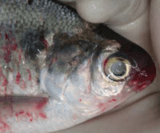Cryptocaryon
| Cryptocaryon irritans | |
|---|---|
| Scientific classification | |
| Domain: | Eukarya |
| Kingdom: | Chromalveolata |
| Superphylum: | Alveolata |
| Phylum: | Ciliophora |
| Class: | Prostomatea |
| Genus: | Cryptocaryon |
| Species: | C. irritans |
| Binomial name | |
| Cryptocaryon irritans | |
Cryptocaryon irritans (also known as marine white spot disease or marine ich[1]) is a species of ciliate protozoa that parasitizes marine fish, and is one of the most common causes of disease in marine aquaria.
Taxonomy
Cryptocaryon irritans was originally classified as Ichthyophthirius marinus, but it is not closely related to the other species. It belongs to the class Prostomatea, but beyond that its placement is still uncertain.
Clinical
The symptoms and life-cycle are generally similar to those of Ichthyophthirius in freshwater fish, including white spots, on account of which Cryptocaryon is usually called marine ich. However, Cryptocaryon can spend a much longer time encysted. Fish that are infected with Cryptocaryon may have small white spots, nodules, or patches on their skin, fins, or gills. They may also have ragged fins, cloudy eyes, pale gills, increased mucus production, or changes in skin color, and they may appear thin. Behaviorally, fish may act different. They may scratch, swim abnormally, act lethargic, hang at the surface or on the bottom, or breathe more rapidly as if they are in distress (http://edis.ifas.ufl.edu/fa164).
-

A Zebrasoma flavescens (Yellow Tang) with ich (Cryptocaryon irritans) on its pectoral fin, snout and behind the eye
Useful treatments (but not reef safe) of Cryptocaryon irritans are copper solutions, formalin solutions and quinine based drugs (such as Chloroquine Phosphate and Quinine Diphosphate).
Infections can be extremely difficult to treat because of other creatures, such as corals and other invertebrates, which will not survive standard treatments. Ideally fish with Cryptocaryon are quarantined in a hospital tank, where they can be treated with a copper salt or using hyposalinity. The display tank needs to be kept clear of fish for 6-9 weeks, the longer the better. This gives time for the encysted tomonts to release infectious theronts, which die within 24-48 hours when they cannot find a host.
References
- ↑ Noga. Fish Disease: Diagnosis and Treatment. 2000.
Yanong, Roy, P.E. (2009). Cryptocaryon irritans infections (marine white spot disease) in fish. http://edis.ifas.ufl.edu/fa164
External links
| ||||||||||||||||||||||||||||||||||||||||||||||||||||||||||||||||||||||||||||||||||||||||||||||||||||||||||||||||||||||||||||||||||||||
